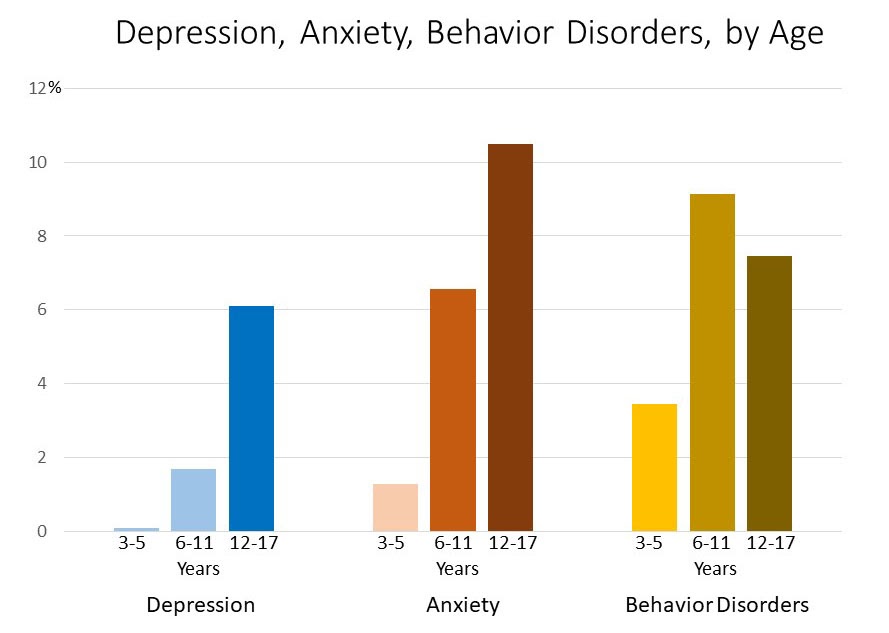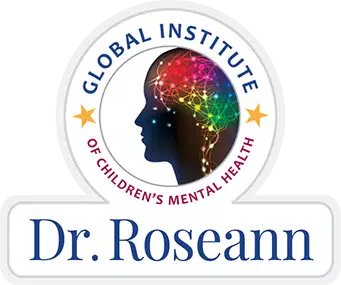Children’s Mental Health Facts
Children’s mental health issues are on the rise...
Chronic childhood illnesses such as ADHD, autism, and mental health issues are on the rise
Delaney, L., & Smith, J. P. (2012)
The number of adolescents who experienced major depressive episodes increased by nearly a third from 2005 to 2014
US Department of Health and Human Services (2019)
The suicide rate among people ages 10 to 24 years old climbed 56% between 2007 and 2017
CDC (2019)
And we aren’t getting treatment soon enough, so our children can live happy, healthy, and productive lives...
The average delay between onset of mental illness symptoms and treatment is 11 years
National Alliance on Mental Illness - NAMI (2019)
...And the signs of mental health concerns are there in young children...
An increasing number of studies indicate that the first signals of behaviour problems can appear as early as infancy and toddlerhood
Skovagaard, et. al., (2007)
17.4% (1 in 6) children 2-8 have a diagnosed mental, behavioral, or developmental disorder
CDC (2020)
One in 5 children entering kindergarten carries a mental health diagnosis
Perrin, Bloom, & Gortmaker (2007)
Half of all mental illnesses begin by the age of 14 and three-quarters by mid-20s
World Health Organization (2020)

Source: Center for Disease Control and Prevention. (2020). Data and Statistics on Children’s Mental Health. https://www.cdc.gov/childrensmentalhealth/data.html
...Parents are worried, so why aren’t they getting the help they are asking for?
Typically, 30% of GP consultations concern child behaviour problems and established behaviour problems can have lasting effects on children’s life chances
Ryan, R., O’Farrelly, C., & Ramchandania, P. (2017)
And when we IGNORE the problem these are the outcomes...
Approximately 1 in 5 youth aged 13–18 (21.4%) experiences a severe mental disorder at some point during their life
National Alliance on Mental Illness - NAMI (2019)
High school students with significant symptoms of depression are more than twice as likely to drop out compared to their peers
National Alliance on Mental Illness - NAMI (2019)
The rate of individuals reporting symptoms consistent with major depression in the last 12 months increased 52 percent in adolescents from 2005 to 2017 (from 8.7 percent to 13.2 percent) and 63 percent in young adults age 18 to 25 from 2009 to 2017 (from 8.1 percent to 13.2 percent)
Skowyra, K., Cozzoza, J. & The National Center for Mental Health and Juvenile Justice Policy Research Associates (2007)
70% of youth in juvenile justice systems have at least one mental health condition and at least 20% live with a serious mental illness
Skowyra, K., Cozzoza, J. & The National Center for Mental Health and Juvenile Justice Policy Research Associates (2007)
At least 8.4 million people in the U.S. provide care to an adult with a mental or emotional health issue
National Alliance on Mental Illness - NAMI (2019)
Mental illness and substance use disorders are involved in 1 out of every 8 emergency department visits by a U.S. adult (estimated 12 million visits)
Owens, P., Mutter, R., & Stocks, C. (2010)
Suicide is the 2nd leading cause of death among people aged 10-34 in the U.S.
Center for Disease Control and Prevention (2019)
Depression and anxiety disorders cost the global economy $1 trillion in lost productivity each year
National Alliance on Mental Illness - NAMI (2019)
THESE STARTLING CHILDREN’S MENTAL HEALTH STATISTICS IS WHY WE ARE LEADING THE CHARGE TO CHANGE CHILDREN’S MENTAL HEALTH ON A GLOBAL LEVEL… THINGS HAVE TO CHANGE FOR CHILDREN AND THEIR FAMILIES
Dr. Roseann
References:
Center for Disease Control and Prevention. (2020). Data and Statistics on Children’s Mental Health. https://www.cdc.gov/childrensmentalhealth/data.html
Center for Disease Control and Prevention (2019). Death rates due to suicide and homicide amoung persons aged 10-24: United States, 200-2017. US Department of Health and Human Services: NCHS Data Brief, Number 352, October. https://www.cdc.gov/nchs/data/databriefs/db352-h.pdf
Delaney, L., & Smith, J. P. (2012). Childhood health: trends and consequences over the life course. The Future of children, 22(1), 43–63. https://doi.org/10.1353/foc.2012.0003
National Alliance on Mental Illness – NAMI (2019). Mental health by the numbers. https://www.nami.org/mhstats
Owens, P., Mutter, R., & Stocks, C. (2010). HEALTHCARE COST AND UTILIZATION PROJECT. Mental Health and Substance Abuse-Related Emergency Department Visits among Adults, 2007. https://www.hcup-us.ahrq.gov/reports/statbriefs/sb92.pdf
Perrin, J., Bloom, S., Gortmaker, S. (2007). The Increase of Childhood Chronic Conditions in the United States. JAMA; 297(24):2755–2759. doi:10.1001/jama.297.24.2755
Ryan, R., O’Farrelly, C., & Ramchandani, P. (2017). Parenting and child mental health. London journal of primary care, 9(6), 86–94. https://doi.org/10.1080/17571472.2017.1361630
Skovgaard, A.M., Houmann, T., Christiansen, E., Landorph, S., Jørgensen, T., , Olsen, E., Heering, K., Kaas‐Nielsen, S., Samberg, V. and Lichtenberg, A. (2007), The prevalence of mental health problems in children 1½ years of age – the Copenhagen Child Cohort 2000. Journal of Child Psychology and Psychiatry, 48: 62-70. doi:10.1111/j.1469-7610.2006.01659.x
Skowyra, K., Cozzoza, J. & The National Center for Mental Health and Juvenile Justice Policy Research Associates (2007). Blueprint for Change: A comprehensive model for the identification and treatment of youth with mental health needs in contact with the juvenile justice system. https://www.ncmhjj.com/wp-content/uploads/2013/07/2007_Blueprint-for-Change-Full-Report.pdf
Twenge, J. Cooper, A., Joiner, T., Duffy, M., & Binau, S. (2019). Age, period, and cohort trends in mood disorder indicators and suicide-related outcomes in a nationally representative dataset, 2005–2017.. Journal of Abnormal Psychology; DOI: 10.1037/abn0000410
US Department of Health and Human Services (2019). Adolescent Mental Health Basics. HHS.org. https://www.hhs.gov/ash/oah/adolescent-development/mental-health/adolescent-mental-health-basics/index.html
World Health Organization (2020). Child and Adolescent Mental Health. https://www.who.int/mental_health/maternal-child/child_adolescent/en/

